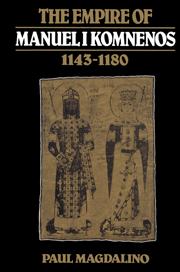Book contents
- Frontmatter
- Contents
- List of maps
- Preface and acknowledgements
- Note on transliteration and citation
- List of abbreviations
- 1 The empire, c. 1150
- 2 The heartland of the Comnenian empire
- Genealogical tables
- Introduction Problems and sources
- 1 The Comnenian empire between East and West
- 2 Constantinople and the provinces
- 3 The Comnenian system
- 4 Government
- 5 The guardians of Orthodoxy
- 6 The emperor and his image
- Epilogue
- Appendix 1 The poems of ‘Manganeios Prodromos’
- Appendix 2 Lay officials in synodal lists of the Comnenian period
- Appendix 3 Magnate ‘patrons’ under Manuel named in verse collections
- Bibliography
- Index
Introduction Problems and sources
Published online by Cambridge University Press: 18 December 2009
- Frontmatter
- Contents
- List of maps
- Preface and acknowledgements
- Note on transliteration and citation
- List of abbreviations
- 1 The empire, c. 1150
- 2 The heartland of the Comnenian empire
- Genealogical tables
- Introduction Problems and sources
- 1 The Comnenian empire between East and West
- 2 Constantinople and the provinces
- 3 The Comnenian system
- 4 Government
- 5 The guardians of Orthodoxy
- 6 The emperor and his image
- Epilogue
- Appendix 1 The poems of ‘Manganeios Prodromos’
- Appendix 2 Lay officials in synodal lists of the Comnenian period
- Appendix 3 Magnate ‘patrons’ under Manuel named in verse collections
- Bibliography
- Index
Summary
The twelfth century was the age of Roger II of Sicily, Henry Plantagenet, Frederick Barbarossa and Saladin. It was also the age of Manuel Komnenos, who ruled the empire of Constantinople from 1143 to 1180. Like his eminent contemporaries, Manuel received more than his fair share of admiration from professional eulogists, yet there can be no doubt that he too provided excellent material for eulogy. Although his accession to the Byzantine throne was sudden, unexpected and precarious, he took control smoothly and efficiently. Only four years later he averted a major crisis when the kings of France and Germany passed through Byzantine territory at the head of huge armies and the king of Sicily took the opportunity to capture Corfu and raid mainland Greece. In addition to many ephemeral successes, Manuel reduced Hungary and the Latin principalities of Outremer to the status of client states. While he reigned, the empire's main centres of population were as secure from internal disorder and foreign invasion as they had ever been. He conducted war and diplomacy on a grand scale and on all fronts. His court was a dazzling display of power and wealth, where state occasions were celebrated with fairytale magnificence. It attracted diplomats, exiles and fortune-seekers from many lands. Manuel also received more foreign potentates than any Byzantine emperor before or since: a king of France, a king of Germany, a Turkish sultan, a king of Jerusalem, and a duke of Saxony and Bavaria.
Information
- Type
- Chapter
- Information
- The Empire of Manuel I Komnenos, 1143–1180 , pp. 1 - 26Publisher: Cambridge University PressPrint publication year: 1993
